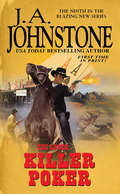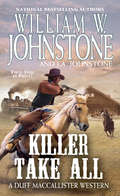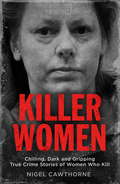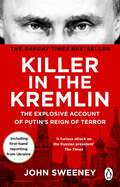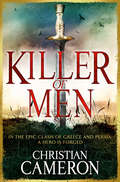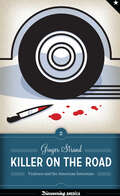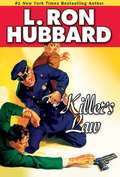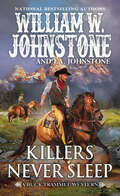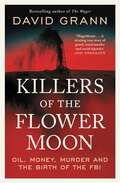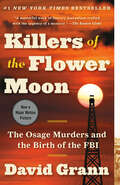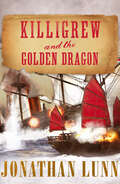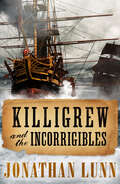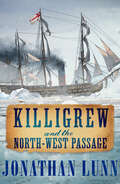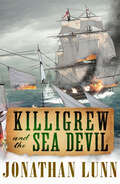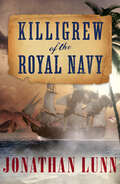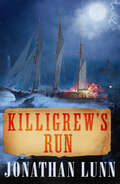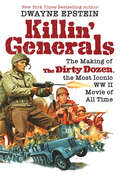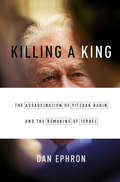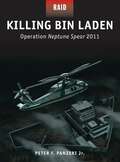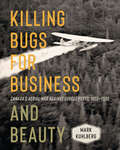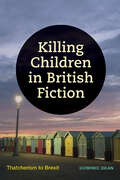- Table View
- List View
Killer Poker: Killer Poker (The Loner #9)
by J.A. JohnstoneIn the Old West, the truth is more than enough to get you killed—from the USA Today–bestselling author of The Bounty Killers.Hunter and the HuntedConrad Browning had money, a manservant and a mission: to find his missing children and meet them for the first time. He&’s come as far as Denver, dodged a bullet from a beautiful assassin, and landed in a big buy-in poker tournament against a ruthless heavy-betting cattle baron with a plan of his own—to take this city slicker into the wilderness, and hunt him like an animal.But Rance McKinney doesn&’t know who he is facing. The son of legendary gunman Frank Morgan, Conrad goes by the moniker of the Loner. Now it&’s the Loner against McKinney, the hunter and the hunted. And when he&’s cornered, the Loner is the most dangerous beast of all . . .&“Another strong entry in this excellent series. The author certainly knows how to craft a tale that will capture the readers imagination from the very beginning, and then piles on the suspense making the book difficult to put down until the gunsmoke drifts away from the scene of the final climactic gunfight.&” —Western Fiction Review
Killer Show: The Station Nightclub Fire, America's Deadliest Rock Concert
by John BarylickOn February 20, 2003, the deadliest rock concert in U.S. history took place at a roadhouse called The Station in West Warwick, Rhode Island. That night, in the few minutes it takes to play a hard-rock standard, the fate of many of the unsuspecting nightclub patrons was determined with awful certainty. The blaze was ignited when pyrotechnics set off by Great White, a 1980s heavy-metal band, lit flammable polyurethane “egg crate” foam sound insulation on the club’s walls. In less than 10 minutes, 96 people were dead and 200 more were injured, many catastrophically. The final death toll topped out, three months later, at the eerily unlikely round number of 100. The story of the fire, its causes, and its legal and human aftermath is one of lives put at risk by petty economic decisions―by a band, club owners, promoters, building inspectors, and product manufacturers. Any one of those decisions, made differently, might have averted the tragedy. Together, however, they reached a fatal critical mass. Killer Show is the first comprehensive exploration of the chain of events leading up to the fire, the conflagration itself, and the painstaking search for evidence to hold the guilty to account and obtain justice for the victims. Anyone who has entered an entertainment venue and wondered, “Could I get out of here in a hurry?” will identify with concertgoers at The Station. Fans of disaster nonfiction and forensic thrillers will find ample elements of both genres in Killer Show.
Killer Take All (A Duff MacCallister Western #10)
by William W. Johnstone J.A. JohnstoneJohnstone Country. A Home Worth Fighting For.Scotsman-turned-cowboy Duff MacCallister traveled far and worked hard to start a new life in America. And anyone who tries to mess with his dream is in for some serious Highland justice . . . KILLER TAKE ALL The cattle town of Chugwater may not look like much to outsiders. But for Duff MacCallister and the determined settlers who’ve staked their futures here, it’s a land of opportunity. That’s why the whole town is fired up by the latest news. Young railroad developer Jacob Freemantle wants to run a rail line through Chugwater, making it easier to transport cattle. Everyone is on board with the plan—at first. Duff begins to suspect that Freemantle is only after the most valuable land, and he’s using strongarm tactics to force reluctant ranchers to sell. Things only get worse when Freemantle’s hired guns show up—and the violence really begins . . .But Duff’s got a plan of his own. With a little help from some well-armed friends, he’s going to flush this phony out of Chugwater—and run his hired killers out of town on a rail . . .Live Free. Read Hard.
Killer Women: Chilling, Dark and Gripping True Crime Stories of Women Who Kill
by Nigel CawthorneThe Chilling Inside Story of Women Who Are Driven to Kill Killer Women are the most disturbing yet compelling of all criminals, representing the very darkest side of humanity and subverting the conventional view of women as the weaker sex. From Elizabeth Bathory, 'The Bloody Countess' whose vampire-like tendencies terrorised sixteenth-century Hungary, to the Moors Murderer Myra Hindley and the Florida Highway Killer Aileen Wuornos, these women transfix us with their extreme ability to commit savage acts of cruelty and depravity. Most chilling is the fact that many of their victims represent the most vulnerable in society: babies, the ill and infirm, and the elderly. In some cases their methods of disposing of the corpses fall nothing short of ingenious: meet Leonarda Cianciulli, 'The Soap-Maker of Correggio', who used the fat from her victims' bodies to make soap and teacakes to sell to unsuspecting customers. These killers' backgrounds, methods and their crimes are described in forensic and gripping detail.50 terrifying cases of killer women are brought to life, including:Elizabeth Bathory 'The Bloody Countess'Amelia Dyer, The Reading Baby FarmerJane Toppan, 'Jolly Jane'Juana Barraza, The Old Lady KillerLeonarda Cianciulli, 'The Soap-Maker of Correggio'Bonnie Parker, 'Bonnie & Clyde'Rosemary WestMyra HindleyAileen Wuornos
Killer Women: Chilling, Dark and Gripping True Crime Stories of Women Who Kill
by Nigel CawthorneThe Chilling Inside Story of Women Who Are Driven to Kill Killer Women are the most disturbing yet compelling of all criminals, representing the very darkest side of humanity and subverting the conventional view of women as the weaker sex. From Elizabeth Bathory, 'The Bloody Countess' whose vampire-like tendencies terrorised sixteenth-century Hungary, to the Moors Murderer Myra Hindley and the Florida Highway Killer Aileen Wuornos, these women transfix us with their extreme ability to commit savage acts of cruelty and depravity. Most chilling is the fact that many of their victims represent the most vulnerable in society: babies, the ill and infirm, and the elderly. In some cases their methods of disposing of the corpses fall nothing short of ingenious: meet Leonarda Cianciulli, 'The Soap-Maker of Correggio', who used the fat from her victims' bodies to make soap and teacakes to sell to unsuspecting customers. These killers' backgrounds, methods and their crimes are described in forensic and gripping detail.50 terrifying cases of killer women are brought to life, including:Elizabeth Bathory 'The Bloody Countess'Amelia Dyer, The Reading Baby FarmerJane Toppan, 'Jolly Jane'Juana Barraza, The Old Lady KillerLeonarda Cianciulli, 'The Soap-Maker of Correggio'Bonnie Parker, 'Bonnie & Clyde'Rosemary WestMyra HindleyAileen Wuornos
Killer in the Kremlin: The instant bestseller - a gripping and explosive account of Vladimir Putin's tyranny
by John SweeneyTHE INSTANT SUNDAY TIMES BESTSELLER - NOW UPDATED WITH FOUR NEW CHAPTERS'This swashbuckling book is a furious attack on the Russian president. Killer in the Kremlin traces Putin's bloody career... a life littered with corpses.' - THE TIMESA gripping and explosive account of Vladimir Putin's tyranny, charting his rise from spy to tsar, exposing the events that led to his invasion of Ukraine and his assault on Europe.In Killer in the Kremlin, award-winning journalist John Sweeney takes readers from the heart of Putin's Russia to the killing fields of Chechnya, to the embattled cities of an invaded Ukraine.In a disturbing exposé of Putin's sinister ambition, Sweeney draws on thirty years of his own reporting - from the Moscow apartment bombings to the atrocities committed by the Russian Army in Chechnya, to the annexation of Crimea and a confrontation with Putin over the shooting down of flight MH17 - to understand the true extent of Putin's long war.Drawing on eyewitness accounts and compelling testimony from those who have suffered at Putin's hand, we see the heroism of the Russian opposition, the bravery of the Ukrainian resistance, and the brutality with which the Kremlin responds to such acts of defiance, assassinating or locking away its critics, and stopping at nothing to achieve its imperialist aims.In the midst of one of the darkest acts of aggression in modern history - Russia's invasion of Ukraine - this book shines a light on Putin's rule and poses urgent questions about how the world must respond.'An extraordinarily prescient and fascinating book.' - NIHAL ARTHANAYAKEInstant Sunday Times bestseller, March 2023
Killer of Men
by Christian CameronIn the epic clash of Greece and Persia, a hero is forged - a monumental novel from the author of the Tyrant series.Arimnestos is a farm boy when war breaks out between the citizens of his native Plataea and their overbearing neighbours, Thebes. Standing in the battle line for the first time, alongside his father and brother, he shares in a famous and unlikely victory. But after being knocked unconscious in the melee, he awakes not a hero, but a slave.Betrayed by his jealous and cowardly cousin, the freedom he fought for has now vanished, and he becomes the property of a rich citizen. So begins an epic journey out of slavery that takes the young Arimnestos through a world poised on the brink of an epic confrontation, as the emerging civilization of the Greeks starts to flex its muscles against the established empire of the Persians. As he tries to make his fortune and revenge himself on the man who disinherited him, Arimnestos discovers that he has a talent that pays well in this new, violent world - for like his hero, Achilles, he is 'a killer of men'.
Killer of Men (The Long War)
by Christian CameronIn the epic clash of Greece and Persia, a hero is forged - a monumental novel from the author of the Tyrant series.Arimnestos is a farm boy when war breaks out between the citizens of his native Plataea and their overbearing neighbours, Thebes. Standing in the battle line for the first time, alongside his father and brother, he shares in a famous and unlikely victory. But after being knocked unconscious in the melee, he awakes not a hero, but a slave.Betrayed by his jealous and cowardly cousin, the freedom he fought for has now vanished, and he becomes the property of a rich citizen. So begins an epic journey out of slavery that takes the young Arimnestos through a world poised on the brink of an epic confrontation, as the emerging civilization of the Greeks starts to flex its muscles against the established empire of the Persians. As he tries to make his fortune and revenge himself on the man who disinherited him, Arimnestos discovers that he has a talent that pays well in this new, violent world - for like his hero, Achilles, he is 'a killer of men'.
Killer of Rome (Carbo of Rome)
by Alex GoughCarbo returns in an unputdownable novel of murder and mystery in ancient RomeAfter years of captivity and torture by German barbarians, former legionary Cicurinus’ ordeal should be over.Hearing of the legendary Carbo, he returns to Rome to seek out this hero who might help to bring him balance. Instead he finds Carbo descending into alcoholism and gambling, a broken man who brutally rebuffs him.Devastated and disgusted by the immoral city around him, Cicurinus, embarks on a rampage of slaughter through Rome’s poor and downtrodden. And to hide his tracks, he frames Carbo for the crimes.With everything at stake, can Carbo master his demons, clear his name, and stop the Killer of Rome?This latest from Alex Gough, a master of the genre, is a Roman thriller that you won’t be able to put down. Perfect for readers of Simon Scarrow, Conn Iggulden and Ben Kane.
Killer on the Road: Violence and the American Interstate (Discovering America #2)
by Ginger StrandTrue crime meets cultural history in this story of how America&’s interstate highway system opened a world of mobility and opportunity . . .for serial killers.Starting in the 1950s, Americans eagerly built the planet&’s largest public work: the 42,795-mile National System of Interstate and Defense Highways. Before the concrete was dry on the new roads, however, a specter began haunting them: the highway killer. He went by many names: the &“Hitcher,&” the &“Freeway Killer,&” the &“Killer on the Road,&” the &“I-5 Strangler,&” and the &“Beltway Sniper.&” Some of these criminals were imagined, but many were real. The nation&’s murder rate shot up as its expressways were built. America became more violent and more mobile at the same time.Killer on the Road tells the entwined stories of America&’s highways and its highway killers. There&’s the hot-rodding juvenile delinquent who led the National Guard on a multistate manhunt; the wannabe highway patrolman who murdered hitchhiking coeds; the record promoter who preyed on &“ghetto kids&” in a city reshaped by freeways; the nondescript married man who stalked the interstates seeking women with car trouble; and the trucker who delivered death with his cargo. Thudding away behind these grisly crime sprees is the story of the interstates—how they were sold, how they were built, how they reshaped the nation—and how we came to equate them with violence.Through the stories of highway killers, we see how the &“killer on the road,&” like the train robber, the gangster, and the mobster, entered the cast of American outlaws, and how the freeway—conceived as a road to utopia—came to be feared as a highway to hell.&“Strand . . . Explores the connection between America&’s sprawling highway system and the pathology of the murderers who have made them a killing ground. . . . The grim stories of murder on the highway may do for road trips what Jaws did for surfing. An interesting detour into a true-crime niche.&” ―Kirkus Reviews&“Strand&’s cross-threaded tales of drifters, stranded motorists, and madmen got its hooks into me. Reading Ms. Strand&’s thoughtful book is like driving a Nash Rambler after midnight on a highway to hell.&” —Dwight Garner, The New York Times&“A titillating, clever volume that mixes the sweeping sociological assertions of an urban-studies textbook with the chilling gore of true-crime stories.&” —Bookforum&“Ginger Strand is in possession of a sharp eye, a biting wit, a beguiling sense of fun—and a magnificent obsession.&” —Bloomberg
Killer's Law
by L. Ron HubbardUnlock your Inner Sherlock... Sheriff Kyle of Deadeye, Nevada has traveled to the nation's capital to personally bring evidence against one of the state's wealthiest copper kings. But instead of giving his findings to the senator he's supposed to meet, Kyle discovers a trail of blood moments before he's knocked unconscious. Kyle awakens to the flashing bulbs of reporters and harsh voices of police demanding to know why he's killed the popular politician. Things look particularly bleak--he's got no alibi, no memory of who knocked him out, and his five-inch knife is sticking out of the corpse--casting all suspicions his way. ALSO INCLUDES THE MYSTERY STORIES "THEY KILLED HIM DEAD", "THE MAD DOG MURDER" AND "THE BLOW TORCH MURDER" "...some of the most carefully and beautifully crafted trade paperbacks of our time." --Mystery Scene
Killers Never Sleep (A Buck Trammel Western #6)
by William W. Johnstone J.A. JohnstoneJohnstone Country. Where Real Cowboys Never Run. They Fight Back.The latest action-packed historical western from national bestselling authors William W. Johnstone and J.A. Johnstone in which former Pinkerton man Buck Trammel takes up the badge in Wyoming Territory. Ben Washington and his gang of murdering prairie rats have been terrorizing Wyoming Territory for quite a spell: rustling cattle, robbing stagecoaches and railroads, and slaughtering settlers. When Sheriff Buck Trammel of Laramie learns that Washington and his killers have been menacing an innocent family, he and his deputy ride out and bring Washington in the hard way—at the barrel of a gun. When word spreads fast of Washington&’s capture, gambler Adam Hagen begins taking wagers on the outlaw&’s fate—where and when his gang will bust him loose—and quickly finds himself sitting atop a mountain of cash. Naturally, greed forces Hagen to open the stakes nationwide. As the stink of easy money grows, the New Orleans gang known as the LeBlanc Brothers crawl into town posing as cattlemen. And the LeBlanc&’s never leave a job empty-handed . . . When the LeBlanc Brothers team up with Washington&’s cut-throats join Washington cut-throats, Trammel is forced to play a dangerous high-stakes game of own where any move he makes could not only cost a deputy his life, but threaten justice in Laramie forever.
Killers of the Flower Moon: Oil, Money, Murder and the Birth of the FBI
by David GrannWINNER OF THE EDGAR AWARD FOR BEST FACT CRIME SHORTLISTED FOR THE ANDREW CARNEGIE MEDAL FOR EXCELLENCE IN NON-FICTION SHORTLISTED FOR THE CWA ALCS GOLD DAGGER FOR NON-FICTION **SOON TO BE A MAJOR MOTION PICTURE DIRECTED BY MARTIN SCORSESE STARRING LEONARDO DICAPRIO AND ROBERT DE NIRO** &‘A riveting true story of greed, serial murder and racial injustice&’ JON KRAKAUER &‘A fiercely entertaining mystery story and a wrenching exploration of evil&’ KATE ATKINSON &‘A fascinating account of a tragic and forgotten chapter in the history of the American West&’ JOHN GRISHAM From the bestselling author of The Lost City of Z, now a major film starring Charlie Hunnam, Sienna Miller and Robert Pattison, and the Number One international bestseller The Wager, comes a true-life murder story which became one of the FBI&’s first major homicide investigations. In the 1920s, the richest people per capita in the world were members of the Osage Indian nation in Oklahoma. After oil was discovered beneath their land, they rode in chauffeured automobiles, built mansions and sent their children to study in Europe. Then, one by one, the Osage began to be killed off. As the death toll climbed, the FBI took up the case. But the bureau badly bungled the investigation. In desperation, its young director, J. Edgar Hoover, turned to a former Texas Ranger named Tom White to unravel the mystery. Together with the Osage he and his undercover team began to expose one of the most chilling conspiracies in American history. &‘David Grann has a razor-keen instinct for suspense&’ LOUISE ERDRICH
Killers of the Flower Moon: The Osage Murders and the Birth of the FBI
by David Grann#1 NEW YORK TIMES BESTSELLER • A twisting, haunting true-life murder mystery about one of the most monstrous crimes in American history, from the author of The Wager and The Lost City of Z, &“one of the preeminent adventure and true-crime writers working today."—New York Magazine • NATIONAL BOOK AWARD FINALIST • NOW A MARTIN SCORSESE PICTURE&“A shocking whodunit…What more could fans of true-crime thrillers ask?&”—USA Today &“A masterful work of literary journalism crafted with the urgency of a mystery.&” —The Boston GlobeA Kirkus Reviews Best Nonfiction Book of the CenturyIn the 1920s, the richest people per capita in the world were members of the Osage Nation in Oklahoma. After oil was discovered beneath their land, the Osage rode in chauffeured automobiles, built mansions, and sent their children to study in Europe.Then, one by one, the Osage began to be killed off. The family of an Osage woman, Mollie Burkhart, became a prime target. One of her relatives was shot. Another was poisoned. And it was just the beginning, as more and more Osage were dying under mysterious circumstances, and many of those who dared to investigate the killings were themselves murdered. As the death toll rose, the newly created FBI took up the case, and the young director, J. Edgar Hoover, turned to a former Texas Ranger named Tom White to try to unravel the mystery. White put together an undercover team, including a Native American agent who infiltrated the region, and together with the Osage began to expose one of the most chilling conspiracies in American history.Look for David Grann&’s latest bestselling book, The Wager!
Killigrew and the Golden Dragon (Kit Killigrew Naval Adventures)
by Jonathan LunnPiracy, bloodshed and betrayal in the early days of Hong Kong…1849, South China Sea: A burning clipper and her slaughtered crew can only be the work of Zhai Jing-mu, China’s most feared and ruthless pirate. Kit Killigrew, HMS Tisiphone’s second lieutenant, captures Zhai after a bloody chase. After handing Zhai to the police, Killigrew is free to enjoy the many pleasures of Hong Kong. But beneath the opulent surface, tensions seethe: the Triads are gaining influence and the hostilities behind the Opium War are all too easily revived. Then Zhai escapes… Soon Killigrew finds treachery and murder around every corner. And somewhere in this tangled web lurks Blase Bannatyne, wealthy tai-pan of the leading company importing opium into China. The game is afoot! The second in a stunning series featuring naval hero Kit Killigrew, Jonathan Lunn’s Killigrew and the Golden Dragon is alive with the sights, sounds and smells of naval adventure. Perfect for fans of Iain Gale, Philip McCutchan and Bernard Cornwell. Praise for the Killigrew Novels‘A hero to rival any Horatio Hornblower. Swashbuckling? You bet’ Belfast Telegraph‘If you revel in the Hornblower and the Sharpe books, grab a copy of Jonathan Lunn’ Bolton Evening News‘A new naval hero who will delight lovers of seafaring yarns’ Manchester Evening NewsThe Kit Killigrew Naval SeriesKilligrew of the Royal NavyKilligrew and the Golden DragonKilligrew and the IncorrigiblesKilligrew and the North-West PassageKilligrew’s RunKilligrew and the Sea Devil
Killigrew and the Incorrigibles (Kit Killigrew Naval Adventures)
by Jonathan LunnDarkness, death and danger on the South SeasSouth Seas, 1850: Kit Killigrew and the Tisiphone are heading towards Norfolk Island, a savage penal colony; ostensibly to drop off the prison chief’s new governess, but also deliver a reporter bent on interviewing Devin Cusack – an Irish political prisoner. But when an unknown party tries to rescue Cusack, seven of the island’s most ruthless prisoners escape, including the fearsome Wyatt. What ensues is a deadly game of cat and mouse among the New Hebrides, where Killigrew unearths a series of illegal trades.Ultimately, it is Killigrew’s state of mind which threatens to achieve what a tribe of cannibals, a band of desperate criminals and a vicious trader – hell bent on profit at any cost – cannot, as he places himself in the line of danger once too often… The third magnificent Killigrew adventure, this is a thrilling maritime ride perfect for fans of C.S. Forester, Patrick O’Brian and Julian Stockwin. Praise for the Killigrew Novels‘A hero to rival any Horatio Hornblower. Swashbuckling? You bet’ Belfast Telegraph‘If you revel in the Hornblower and the Sharpe books, grab a copy of Jonathan Lunn’ Bolton Evening News‘A new naval hero who will delight lovers of seafaring yarns’ Manchester Evening NewsThe Kit Killigrew Naval SeriesKilligrew of the Royal NavyKilligrew and the Golden DragonKilligrew and the IncorrigiblesKilligrew and the North-West PassageKilligrew’s RunKilligrew and the Sea Devil
Killigrew and the North-West Passage (Kit Killigrew Naval Adventures)
by Jonathan LunnMaritime action in the frozen Arctic 1852: It would be one of the most famous rescue missions ever attempted. For Lieutenant Kit Killigrew, the opportunity to search the Arctic for Sir John Franklin’s ill-fated expedition is a dream come true. Soon it becomes the stuff of nightmares. When a captain more interested in personal glory than safety forces them into uncharted waters, Killigrew begins to doubt they will ever get out alive, let alone find Franklin. As desperation sets in, Killigrew knows he must act. But then, to add to their troubles, a creature of almost mythical proportions starts to pick off the crew, one by one…Killigrew and the North-West Passage evokes the true horror of an Arctic winter. Jonathan Lunn’s most chilling and exciting novel yet is perfect for readers of Bernard Cornwell and Patrick O’Brian.Praise for the Killigrew Novels‘Leaves the reader breathless for his next voyage’ Northern Echo‘Action-packed and well-researched… in the vein of Forester and O’Brian but with its own distinctive flavour’ Good Book Guide‘A rollicking tale with plenty of punches’ Lancashire Evening Post‘A hero to rival any Horatio Hornblower. Swashbuckling? You bet’ Belfast TelegraphThe Kit Killigrew Naval SeriesKilligrew of the Royal NavyKilligrew and the Golden DragonKilligrew and the IncorrigiblesKilligrew and the North-West PassageKilligrew’s RunKilligrew and the Sea Devil
Killigrew and the Sea Devil (Kit Killigrew Naval Adventures)
by Jonathan LunnThe gripping conclusion to the Kit Killigrew Naval Adventures1855: When Commander Kit Killigrew is framed for murder by his old foe, the Russian Colonel Nekrasoff, he must plunge into the murky depths of the Victorian underworld to escape.Before long he is on an undercover mission to St Petersburg, tracking down a missing engineer to discover the whereabouts of a secret weapon known as the Sea Devil…But in a world of espionage, nothing is as it seems. Killigrew must unravel the conspiracy before the trail finally leads to him the fortress of Sveaborg in his most explosive adventure yet.The blistering conclusion of the Killigrew Naval Adventures takes you into the dramatic heart of war at sea. A fitting ending, perfect for readers of C.S. Forester, Patrick O’Brian and Julian Stockwin.Praise for the Killigrew Novels‘Leaves the reader breathless for his next voyage’ Northern Echo‘Action-packed and well-researched… in the vein of Forester and O’Brian but with its own distinctive flavour’ Good Book Guide‘A rollicking tale with plenty of punches’ Lancashire Evening Post‘A hero to rival any Horatio Hornblower. Swashbuckling? You bet’ Belfast TelegraphThe Kit Killigrew Naval SeriesKilligrew of the Royal NavyKilligrew and the Golden DragonKilligrew and the IncorrigiblesKilligrew and the North-West PassageKilligrew’s RunKilligrew and the Sea Devil
Killigrew of the Royal Navy (Kit Killigrew Naval Adventures)
by Jonathan LunnEpic action and adventure from the glory days of naval power.1847: Despite the best efforts of the Royal Navy, transatlantic slavers continue to profit from the illegal trade. Idealistic young naval officer Kit Killigrew wants to stop them. With the aid of Rear-Admiral Sir Charles Napier, Killigrew hatches a daring plan to infiltrate the slavers and discover the whereabouts of the biggest slave market in West Africa. But Kit will also need find out the identity of a shadowy British figure, one of the slave trade’s major investors. A veteran of campaigns in Syria and China, Killigrew now sets out on a perilous high-seas adventure that will challenge him to his very limits…Full of sea-salt, gunpowder and nail-biting naval action, this is the first in the extraordinary Killigrew naval dramas, perfect for fans of C.S. Forester, Patrick O’Brian and Julian Stockwin. Praise for the Killigrew Novels‘A hero to rival any Horatio Hornblower. Swashbuckling? You bet’ Belfast Telegraph‘If you revel in the Hornblower and the Sharpe books, grab a copy of Jonathan Lunn’ Bolton Evening News‘A new naval hero who will delight lovers of seafaring yarns’ Manchester Evening NewsPreviously published asKilligrew R.N.
Killigrew's Run (Kit Killigrew Naval Adventures)
by Jonathan LunnKilligrew meets his match as the Crimean War hots up The Baltic, 1854: Navies, like armies, have camp followers, and the British fleet that sails to the Baltic on the eve of the Crimean War is no exception. Along with the floating grog shop and brothels come ‘war tourists’ – aristocratic gentlemen travelling to see the war first-hand.When Viscount Bullivant is taken prisoner by the Russians, it falls to Commander Kit Killigrew to negotiate his release. But the Russians suspect his lordship has vital information and before long Killigrew is a prisoner of the Third Section – the feared Tsarist secret police.In the ensuing forty-eight hours, Killigrew must escape, rescue Bullivant, steal back his yacht, sail through the treacherous Ekenäs Archipelago and take on a Russian ship with an unarmed schooner. And in Captain-Lieutenant Count Mikhail Yurievich Pechorin, he may finally have met his match…Praise for the Killigrew Novels‘Leaves the reader breathless for his next voyage’ Northern Echo‘Action-packed and well-researched… in the vein of Forester and O’Brian but with its own distinctive flavour’ Good Book Guide‘A rollicking tale with plenty of punches’ Lancashire Evening Post‘A hero to rival any Horatio Hornblower. Swashbuckling? You bet’ Belfast TelegraphThe Kit Killigrew Naval SeriesKilligrew of the Royal NavyKilligrew and the Golden DragonKilligrew and the IncorrigiblesKilligrew and the North-West PassageKilligrew’s RunKilligrew and the Sea Devil
Killin' Generals: The Making of The Dirty Dozen, the Most Iconic WW II Movie of All Time
by Dwayne EpsteinAn explosive inside look at The Dirty Dozen, the star-studded war film that broke the rules, shocked the critics, thrilled audiences, and became an all-time, cult-movie classic . . . The year was 1967. A cinematic blockbuster exploded across American popular culture. The Dirty Dozen didn&’t just reinvent the &“men on a mission&” war story, it blew the genre to pieces. Like its ragtag team of crazies, murderers, and misfits, it defied authority, mocked the military, and still managed to deliver action, adventure, and no-holds-barred Nazi-killing. It also received four Oscar nominations, launched the careers of many Hollywood legends, and inspired generations of filmmakers like Sam Peckinpah, Quentin Tarantino, and James Gunn. Based on exclusive interviews with the surviving cast and crew, friends and families of the stars, and other Hollywood insiders, Killing Generals is a riveting must-read for film buffs, military fans, and anyone who loves a down-and-dirty adventure tale. To quote the character played by Charles Bronson, &“Boy oh boy—killing generals could get to be a habit with me.&” Detailed, insightful, and gossipy, Epstein&’s homage spotlights the movie&’s endless barrage of cinematic gold. During a time when America was reeling from turmoil—the Vietnam War, civil rights protests, social upheaval—Hollywood held an indelible mirror up to a changing society. Films like Bonnie and Clyde, The Graduate, Guess Who&’s Coming to Dinner, Cool Hand Luke, and In the Heat of the Night would define the era. But it was a gritty, violent, darkly comic World War II movie called The Dirty Dozen that would really strike a chord with audiences—and become the year&’s biggest box office success. Heading up the all-star cast were Lee Marvin, Ernest Borgnine, John Cassavettes, Charles Bronson, Donald Sutherland, Jim Brown, Robert Ryan, Clint Walker, and at his most terrifying best, Telly Savalas, propelling many of them to stardom. More than a viewing companion to an iconic film, Killin&’ Generals brings to vivid life a pivotal epic in American history and pop culture, when going to the movies—in person—was a way of life shared by millions.
Killing A King
by Dan EphronThe assassination of Israeli Prime Minister Yitzhak Rabin remains the single most consequential event in Israel's recent history, and one that fundamentally altered the trajectory for both Israel and the Palestinians. Killing a King relates the parallel stories of Rabin and his stalker, Yigal Amir, over the two years leading up to the assassination, as one of them planned political deals he hoped would lead to peace, and the other plotted murder. Dan Ephron, who reported from the Middle East for much of the past two decades, covered both the rally where Rabin was killed and the subsequent murder trial. He describes how Rabin, a former general who led the army in the Six-Day War of 1967, embraced his nemesis, Palestine Liberation Organization leader Yasser Arafat, and set about trying to resolve the twentieth century's most vexing conflict. He recounts in agonizing detail how extremists on both sides undermined the peace process with ghastly violence. And he reconstructs the relentless scheming of Amir, a twenty-five-year-old law student and Jewish extremist who believed that Rabin's peace effort amounted to a betrayal of Israel and the Jewish people. As Amir stalked Rabin over many months, the agency charged with safeguarding the Israeli leader missed key clues, overlooked intelligence reports, and then failed to protect him at the critical moment, exactly twenty years ago. It was the biggest security blunder in the agency's history. Through the prism of the assassination, much about Israel today comes into focus, from the paralysis in peacemaking to the fraught relationship between current Prime Minister Benjamin Netanyahu and President Barack Obama. Based on Israeli police reports, interviews, confessions, and the cooperation of both Rabin's and Amir's families, Killing a King is a tightly coiled narrative that reaches an inevitable, shattering conclusion. One can't help but wonder what Israel would look like today had Rabin lived.
Killing Bin Laden - Operation Neptune Spear 2011
by Johnny Shumate Peter PanzeriOn May 2, 2011 a ten-year manhunt drew to a deadly end as the men of the US Naval Special Warfare Development Group (a.k.a. SEAL Team Six) closed in on their prey, Osama Bin Laden, the fanatical mastermind of the terrible attack on the World Trade Center on September 11, 2001. Flown from Afghanistan by Army Special Operations Command's 160th Special Operations Aviation Regiment (Airborne) and evading detection by the Pakistani military, two US helicopters flew towards the compound where they believed Bin Laden to be.Forty minutes later one helicopter had crashed and five men were dead, including the al-Qaeda leader, whose body was taken away and quietly buried at sea. In this book the story of the raid is told, from start to finish, using specially commissioned full-colour artwork, photographs and maps. The operation, codenamed Neptune Spear, is expertly analysed and the events are told in a concise and clear account of its build-up, execution and aftermath, demonstrating the skill and courage of the men who carried it out.
Killing Bugs for Business and Beauty: Canada’s Aerial War against Forest Pests, 1913–1930
by Mark KuhlbergKilling Bugs for Business and Beauty examines the beginning of Canada’s aerial war against forest insects and how a tiny handful of officials came to lead the world with a made-in-Canada solution to the problem. Shedding light on a largely forgotten chapter in Canadian environmental history, Mark Kuhlberg explores the theme of nature and its agency. The book highlights the shared impulses that often drove both the harvesters and the preservers of trees, and the acute dangers inherent in allowing emotional appeals instead of logic to drive environmental policy-making. It addresses both inter-governmental and intra-governmental relations, as well as pressure politics and lobbying. Including fascinating tales from Cape Breton Island, Muskoka, and Stanley Park, Killing Bugs for Business and Beauty clearly demonstrates how class, region, and commercial interest intersected to determine the location and timing of aerial bombings. At the core of this book about killing bugs is a story, infused with innovation and heroism, of the various conflicts that complicate how we worship wilderness.
Killing Children in British Fiction: Thatcherism to Brexit
by Dominic DeanThis book stems from a simple yet disturbing observation: contemporary British fiction is full of children killing or being killed. Thoughtfully considering novels and films, alongside actual murder cases and moral panics, Dominic Dean develops this insight into a complex account of British cultural history, from the Thatcher to Brexit eras. Killing Children in British Fiction argues that the figure of the child provides means for negotiating, and hence for understanding, recent crises in Britain and their intersections with broader transnational conflicts. The book explores works from major British authors such as Kazuo Ishiguro, Ian McEwan, Doris Lessing, Sarah Waters, Alan Hollinghurst, and Peter Ackroyd; emerging writers such as David Szalay and Melissa Harrison; and filmmakers, including Stanley Kubrick, Nicholas Roeg, Robin Hardy, Derek Jarman, and Remi Weekes. Bridging and often challenging existing scholarship in childhood studies, literary studies, psychoanalysis, and critical and queer theory, Dean shows how the child, at once materially present and representative of an insecure future, can provoke relentless fantasies, fears, and, most troublingly, acts of real violence by adults.
